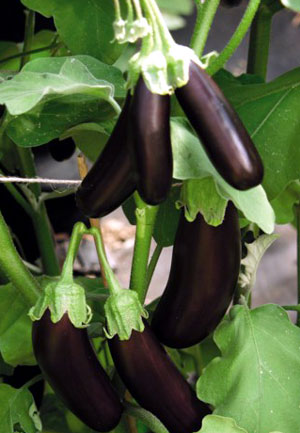|
|
The current control of insects in capsicum and eggplant crops relies heavily on scheduled applications of insecticides. For some pests there are few or no registered products, while insecticide resistance is an increasing issue. This project is a first in an attempt to develop Integrated Pest Management (IPM) systems in these crops. It is based on the relationship between the insect pests and beneficial insects. Other projects have concentrated on developing controls for some of the pests in these crops. The results from those projects and from personal experience, in working on insects in vegetable crops, have contributed to the final outcomes of this project. This publication is the final report for project VG00026 Developing and Implementing Integrated Pest Management Systems for Eggplant and Capsicum outlining the work undertaken and the outcomes achieved for the Eggplant and Capsicum industries.
Summary : In eggplant (Solanum melongena L) and capsicum (Capsicum annuum L) the management practices for insect pests rely heavily on scheduled insecticide applications. The most important and common insects to both crops are Heliothis [Helicoverpa armigera (Hubner)], aphids [Myzus persicae (Sulzer) and Aphis gossypii Glover)] and eggfruit caterpillar [Sceliodes cordalis (Doubleday)]. Other major pests include silverleaf whitefly [Bemisia tabaci type B] that mainly infests eggplant and a number of thrips species [Thrips spp. and Frankliniella sp.]. Other minor insect pests belonging to a number of insect orders also attack these crops. Successful IPM is based on control options that are economically sound, environmentally acceptable and user friendly, as well as producing a marketable product. Outcomes from this project showed that scouting methods could determine insect numbers in capsicum crops. The main part of the plant to sample was the top 1/3 of the plant. By sampling 5 randomly selected leaves per plant with a sample size of 1 plant in 300 plants up to a maximum of 50 plants examined, would give a reasonable estimate of the insect population within that crop. If all insects were recorded then an average of 0.12 beneficial insects, mainly ladybird beetles, lacewings or parasitic wasps, would control an aphid population with an average of up to 6 per leaf. Control for Heliothis would be needed if no parasitism was recorded and an average of 5 eggs or 1 larva was counted per 10 plants. Variations to that number depended on the percentage of egg parasitism by Trichogramma spp. and the number of other beneficial insects that prey on them. Pheromone trapping for eggfruit caterpillar and Heliothis adults is not a reliable indicator of their activity in the crop. Research showed that the area to check for eggfruit caterpillar is along the fruit stalk and on the fruit. This is the preferred site for egg laying. Eggs are white when first laid and develop red stripes down the side of the egg within a day. The larvae burrow into the fruit within a few hours of emerging from the egg. Results from this project have shown that with this information, an IPM system in capsicum can be successful. This has been demonstrated in study plots, on grower properties and on research stations. The adoption of IPM system in capsicums has been slow and this has been due to the delay in the publication of the insect booklet. Without the ability to identify the insect, as a pest or beneficial, it is difficult to adopt and implement an IPM system. Future development of IPM in capsicum crops should be directed at the involvement of growers in using the crop monitoring technique with the insect identification book. Integrated Pest Management in eggplant crops has not been successful. Future work will need to consider softer type controls for the silverleaf whitefly. The development of IPM in this crop maybe possible, if the current release of the introduced parasite is successful. Recommendations : With most vegetables the slightest marking on the fruit can make it unacceptable for the market. Integrated Pest Management systems have been developed in vegetables but their adoption is sometimes slow due to a number of factors. The price received for a commodity is a major factor. In times of high prices chemical costs are not important in the economic equation but as the price of produce falls, the costs of chemicals becomes important and this is when IPM will start to be adopted. Integrated Pest Management systems appear complex but arent, mostly relying on crop monitoring to gauge insect numbers and adoption of good farming techniques. These include; having crop breaks, weed control, destruction of old crop residues and use of specific insecticides i.e. biological types for Heliothis. With the aid of the insect identification book no one should be disadvantaged in undertaking crop monitoring as the old problem of not being able to distinguish insect pests from noninsect pests is removed. This has been the major stumbling block in the adoption of IPM. Acknowledgements : We gratefully acknowledge the assistance of the following organisations and individuals who have contributed to the project :
This research was funded by Horticulture Australia and the Department of Primary Industries & Fisheries, Queensland. The Australian Government provides matched funding for all HALs R&D activities. |
||||
|

